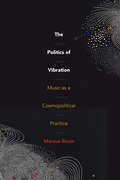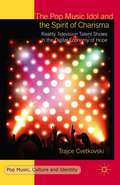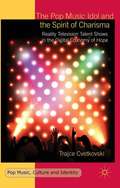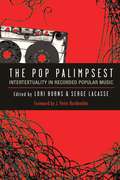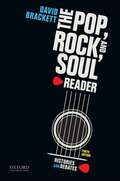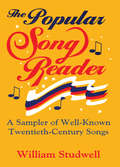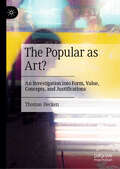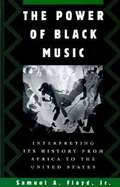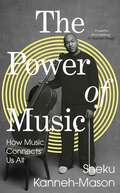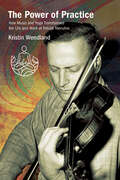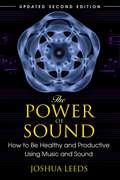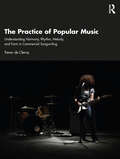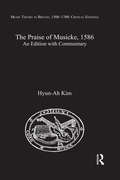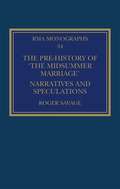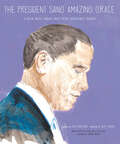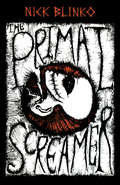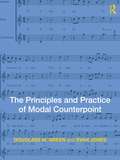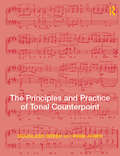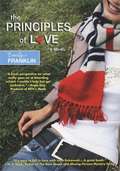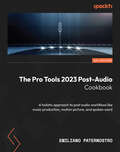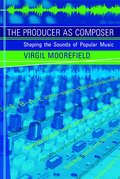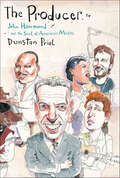- Table View
- List View
The Politics of Vibration: Music as a Cosmopolitical Practice
by Marcus BoonIn The Politics of Vibration Marcus Boon explores music as a material practice of vibration. Focusing on the work of three contemporary musicians—Hindustani classical vocalist Pandit Pran Nath, Swedish drone composer and philosopher Catherine Christer Hennix, and Houston-based hip-hop musician DJ Screw—Boon outlines how music constructs a vibrational space of individual and collective transformation. Contributing to a new interdisciplinary field of vibration studies, he understands vibration as a mathematical and a physical concept, as a religious or ontological force, and as a psychological determinant of subjectivity. Boon contends that music, as a shaping of vibration, needs to be recognized as a cosmopolitical practice—in the sense introduced by Isabelle Stengers—in which what music is within a society depends on what kinds of access to vibration are permitted, and to whom. This politics of vibration constitutes the hidden ontology of contemporary music because the organization of vibration shapes individual music scenes as well as the ethical choices that participants in these scenes make about how they want to live in the world.
The Polyphonic Mass in France, 1600–1780
by Montagnier Jean-Paul C.This is the first ever book-length study of the a cappella masses which appeared in France in choirbook layout during the baroque era. Though the musical settings of the Ordinarium miss#65533; and of the Missa pro defunctis have been the subject of countless studies, the stylistic evolution of the polyphonic masses composed in France during the seventeenth and eighteenth centuries has been neglected owing to the labor involved in creating scores from the surviving individual parts. Jean-Paul C. Montagnier has examined closely the printed, engraved and stenciled choirbooks containing this repertoire, and his book focuses mainly on the music as it stands in them. After tracing the choirbooks' publishing history, the author places these mass settings in their social, liturgical and musical context. He shows that their style did not all adhere strictly to the stile antico, but could also employ the most up-to-date musical language of the period.
The Pop Music Idol and the Spirit of Charisma: Reality Television Talent Shows in the Digital Economy of Hope (Pop Music, Culture and Identity)
by T. CvetkovskiThis book makes a case for the synergetic union between reality TV and the music industry. It delves into technological change in popular music, and the role of music reality TV and social media in the pop production process. It challenges the current scholarship which does not adequately distinguish the economic significance of these developments.
The Pop Music Idol and the Spirit of Charisma: Reality Television Talent Shows in the Digital Economy of Hope (Pop Music, Culture and Identity)
by Trajce CvetkovskiThis book makes a case for the synergetic union between reality TV and the music industry. It delves into technological change in popular music, and the role of music reality TV and social media in the pop production process. It challenges the current scholarship which does not adequately distinguish the economic significance of these developments.
The Pop Palimpsest: Intertextuality in Recorded Popular Music (Tracking Pop)
by Lori Burns Serge LacasseWithin popular music there are entire genres (jazz “standards”), styles (hip hop), techniques (sampling), and practices (covers) that rely heavily on references between music of different styles and genres. This interdisciplinary collection of essays covers a wide range of musical styles and artists to investigate intertextuality—the shaping of one text by another—in popular music. The Pop Palimpsest offers new methodologies and frameworks for the analysis of intertextuality in popular music, and provides new lenses for examining relationships between a variety of texts both musical and nonmusical. Enriched by perspectives from multiple subdisciplines, The Pop Palimpsest considers a broad range of intertextual relationships in popular music to explore creative practices and processes and the networks that intertextual practices create between artists and listeners.
The Pop, Rock, and Soul Reader: Histories and Debates
by David BrackettFeaturing more than 100 readings from a wide range of sources and writers, The Pop, Rock, and Soul Reader has established itself as the #1 reader on the market for popular music studies. It provides a rich and engaging introduction to the development of American popular music and the important social and cultural issues raised by its study. Editor David Brackett brings together a vast array of selections from sources that include mainstream and specialized magazines, newspapers, scholarly journals, interviews, and autobiographies of musicians and other music industry insiders.
The Popular Song Reader: A Sampler of Well-Known Twentieth-Century Songs
by Frank Hoffmann William E Studwell Beulah B RamirezWho is the Bill Bailey whose exploits were chronicled in song? How many popular songs have titles containing the words “moon,” “heart,” or “baby”? Where is the road to Mandalay? How many female names can you think of that have been mentioned in song titles? Discover this fascinating information and more about some of America's most known and loved popular songs in this delightful sampler. The Popular Song Reader contains over 200 short essays on the backgrounds of a wide variety of twentieth-century American popular songs. The witty and knowledgeable essays touch upon several hundred traditional-style pop songs as well as early rock compositions. The essays are filled with anecdotes, humor, irony, and even poetry that reflect the author's offbeat and somewhat irreverent manner, while also presenting a broad spectrum of American popular songs in their historical and cultural contexts. In addition to information about each song and its composer, the author also discusses how the song reflected society at the time and also how the song itself has influenced popular culture. Pop music fans will find this a highly entertaining and readable guide to the best American popular music of the twentieth century. Divided into five sections, the book covers popular songs from the Tin Pan Alley era (By the Light of the Silvery Moon, California, Here I Come, Let Me Call You Sweetheart, She'll Be Comin’Round the Mountain, and When Irish Eyes are Smiling), the swing/big band era (Don't Get Around Much Anymore, Heart and Soul, In the Mood, Stardust, and Stormy Weather), and the rock era (Chances Are, Good Vibrations, Love Me Tender, Misty, Rock Around the Clock, Stop! In the Name of Love, and The Twist). The Popular Song Reader provides new insights on all-time favorites from Broadway musicals, movies, and television including Ain't Misbehavin', Give My Regards to Broadway, My Funny Valentine, Aquarius, Cabaret, Luck Be a Lady, Mack the Knife, Don't Fence Me In, Over the Rainbow, Singin’in the Rain, and the theme songs from Star Wars , All in the Family, Cheers, and M*A*S*H.
The Popular and the Sacred in Music
by Antti-Ville KärjäMusic, as the form of art whose name derives from ancient myths, is often thought of as pure symbolic expression and associated with transcendence. Music is also a universal phenomenon and thus a profound marker of humanity. These features make music a sphere of activity where sacred and popular qualities intersect and amalgamate. In an era characterised by postsecular and postcolonial processes of religious change, re-enchantment and alternative spiritualities, the intersections of the popular and the sacred in music have become increasingly multifarious. In the book, the cultural dynamics at stake are approached by stressing the extended and multiple dimensions of the sacred and the popular, hence challenging conventional, taken-for-granted and rigid conceptualisations of both popular music and sacred music. At issue are the cultural politics of labelling music as either popular or sacred, and the disciplinary and theoretical implications of such labelling. Instead of focussing on specific genres of popular music or types of religious music, consideration centres on interrogating musical situations where a distinction between the popular and the sacred is misleading, futile and even impossible. The topic is discussed in relation to a diversity of belief systems and different repertoires of music, including classical, folk and jazz, by considering such themes as origin myths, autonomy, ingenuity and stardom, authenticity, moral ambiguity, subcultural sensibilities and political ideologies.
The Popular as Art?: An Investigation into Form, Value, Concepts, and Justifications
by Thomas HeckenThis book will reconstruct and analyze the logic and frameworks surrounding positive evaluations of popular art in articles and books predominantly published in the United States and western Europe. It will also examine negative evaluations of the popular, especially those that have successfully prevented the popular from being perceived as (good) art and still provide partially effective counterarguments today. This book will examine both relevant judgments on individual works and groups of works as well as general judgments and assessments.
The Possibility Machine: Music and Myth in Las Vegas (Music in American Life)
by Kelly Kessler Joanna Dee Das Jake Johnson James Deaville Robert Fink Janis McKay Louis Niebur Cassaundra Rodriguez Celine Ayala Kirstin Bews Laura Dallman Pheaross Graham Jessica A Holmes Maddie House-Tuck Michael Kinney Carlo Lanfossi Jason Leddington Sam Murray Lynda Paul Arianne Johnson Quinn Michael M Reinhard Laura Risk Arreanna Rostosky Brian F WrightSingular and star-studded writings on America’s neon-lit playground At once a Technicolor wonderland and the embodiment of American mythology, Las Vegas exists at the Ground Zero of a reverence for risk-taking and the transformative power of a winning hand. Jake Johnson edits a collection of short essays and flash ideas that probes how music-making and soundscapes shape the City of Second Chances. Treating topics ranging from Cher to Cirque de Soleil, the contributors delve into how music and musicians factored in the early development of Vegas’s image; the role of local communities of musicians and Strip mainstays in sustaining tensions between belief and disbelief; the ways aging showroom stars provide a sense of timelessness that inoculates visitors against the outside world; the link connecting fantasies of sexual prowess and democracy with the musical values of Liberace and others; considerations of how musicians and establishments gambled with identity and opened the door for audience members to explore Sin City–only versions of themselves; and the echoes and energy generated by the idea of Las Vegas as it travels across the country. Contributors: Celine Ayala, Kirstin Bews, Laura Dallman, Joanna Dee Das, James Deaville, Robert Fink, Pheaross Graham, Jessica A. Holmes, Maddie House-Tuck, Jake Johnson, Kelly Kessler, Michael Kinney, Carlo Lanfossi, Jason Leddington, Janis McKay, Sam Murray, Louis Niebur, Lynda Paul, Arianne Johnson Quinn, Michael M. Reinhard, Laura Risk, Cassaundra Rodriguez, Arreanna Rostosky, and Brian F. Wright
The Power of Black Music: Interpreting its History from Africa to the United States
by Samuel A. Floyd<p>When Jimi Hendrix transfixed the crowds of Woodstock with his gripping version of "The Star Spangled Banner," he was building on a foundation reaching back, in part, to the revolutionary guitar playing of Howlin' Wolf and the other great Chicago bluesmen, and to the Delta blues tradition before him. But in its unforgettable introduction, followed by his unaccompanied "talking" guitar passage and inserted calls and responses at key points in the musical narrative, Hendrix's performance of the national anthem also hearkened back to a tradition even older than the blues, a tradition rooted in the rings of dance, drum, and song shared by peoples across Africa. <p>Bold and original, The Power of Black Music offers a new way of listening to the music of black America, and appreciating its profound contribution to all American music. Striving to break down the barriers that remain between high art and low art, it brilliantly illuminates the centuries-old linkage between the music, myths and rituals of Africa and the continuing evolution and enduring vitality of African-American music. Inspired by the pioneering work of Sterling Stuckey and Henry Louis Gates, Jr., author Samuel A. Floyd, Jr, advocates a new critical approach grounded in the forms and traditions of the music itself.</p>
The Power of Music: A celebration of how music connects us all, from the internationally-renowned young musician
by Sheku Kanneh-Mason'Sheku believes that the future of classical music is bright, and in the hands of young musicians like him, it certainly is’ John SuchetMusic is what makes us alive, mindful and connected to each other. Music is what makes us human. This is the power of music.Cellist Sheku Kanneh-Mason knows and feels the transformative power of music as much as any musician alive. From winning the prestigious BBC Young Musician Award to performing at Harry and Meghan’s wedding; from Bach’s solo suites to Bob Marley’s reggae; his ferocious passion shines through in every single performance, whether in a packed-out concert hall or on record.But how was it that someone like him – a person of colour, from a state school in Nottingham – rose to the upper echelons of the classical music world? What were the obstacles that he had to overcome, what did he learn along the way, and how could a young person follow in his footsteps today?In The Power of Music, Sheku explores the experiences and values that led him here, from a childhood of football practice and family music sessions, to his work today in the world’s finest concert halls and in the less privileged communities that surround them. As his star continues to rise, he shows us the darker side of an industry ruled by exclusivity and stubborn adherence to tradition.With its power to transform our mental and physical health, to effect social change, and to make a house a home, Sheku shows us that classical music is for everyone, not just an elite few. The Power of Music is a celebration of music of all sorts and those who make it, and a rallying call to change.‘A heartfelt plea for the importance of excellence in music performance and education, from one of the leading role models of our time' Sir Nicholas Kenyon, former director of the BBC Proms and Barbican Centre'Powerful and inspiring' Sir Stephen Hough
The Power of Practice: How Music and Yoga Transformed the Life and Work of Yehudi Menuhin (SUNY Press Open Access)
by Kristin WendlandThe Power of Practice showcases the pioneering achievements of renowned violinist Yehudi Menuhin (1916-99) and how both disciplines transformed his life and practice. Menuhin's contributions as a performer, teacher, and humanitarian are celebrated around the world. Less well known, however, is Menuhin's devotion to the practice of yoga and his close friendship with the renowned yogi B. K. S. Iyengar (1918–2014), whose guidance profoundly influenced Menuhin as both a musician and a philanthropist. Menuhin applied his understanding of Iyengar's teachings to his philosophy of musical practice, creating new ways to approach the teaching of violin technique. He also took broader lessons from yoga to inform his approach to interacting with the larger world as a cultural ambassador and influential artist. Through the lens of the life and work of the celebrated violinist and devoted yogi, this book uncovers deep connections between music and yoga. It shows how the practice of both disciplines can profoundly transform our world into a better place.
The Power of Sound: How to Be Healthy and Productive Using Music and Sound
by Joshua LeedsCustomize your sound environment for a better quality of life • Shows how to use music and sound to reduce stress, enhance learning, and improve performance • Provides detailed guidelines for musicians and health care professionals • Includes a new 75-minute CD of psychoacoustically designed classical music What we hear, and how we process it, has a far greater impact on our daily living than we realize. From the womb to the moment we die we are surrounded by sound, and what we hear can either energize or deplete our nervous systems. It is no exaggeration to say that what goes into our ears can harm us or heal us. Joshua Leeds--a pioneer in the application of music for health, learning, and productivity--explains how sound can be a powerful ally. He explores chronic sensory overload and how auditory dysfunction often results in difficulties with learning and social interactions. He offers innovative techniques designed to invigorate auditory skills and provide balanced sonic environments. In this revised and updated edition of The Power of Sound, Leeds includes current research, extensive resources, analysis of the maturing field of soundwork and a look at the effect of sound on animals. He also provides a new 75-minute CD of psychoacoustically designed classical music for a direct experience of the effect of simplified sound on the nervous system. With new information on how to use music and sound for enhanced health and productivity, The Power of Sound provides readers with practical solutions for vital and sustained well-being.
The Practice of Popular Music: Understanding Harmony, Rhythm, Melody, and Form in Commercial Songwriting
by Trevor de ClercqThe Practice of Popular Music is a music theory and musicianship textbook devoted to explaining the organization of contemporary popular music styles such as pop, rock, R&B, rap, and country. Rooted in recent research showing that the structure of popular music differs from classical music in important ways, this textbook offers an approach to teaching music theory that is fully oriented around popular and commercial genres.Beginning with fundamentals and requiring no previous training in music theory or notation, this book eventually guides the reader through a range of advanced topics, including chromatic mixture, secondary chord function, complex time signatures, and phrase organization. Each chapter develops concepts in tandem with aural comprehension, and the included exercises balance written tasks with listening activities. A companion website provides links to playlists of the music discussed in the book.With an innovative approach designed to broaden the reach of music theory coursework to a wide range of students, including non-majors and those in modern music degree programs such as audio engineering, songwriting, and music business, this textbook enables readers to gain a deep understanding of music theory in the context of popular music.
The Praise of Musicke, 1586: An Edition with Commentary (Music Theory in Britain, 1500–1700: Critical Editions)
by Hyun-Ah KimThis volume provides the first printed critical edition of The Praise of Musicke (1586), keeping the original text intact and accompanied by an analytical commentary. Against the Puritan attacks on liturgical music, The Praise of Musicke, the first apologetic treatise on music in English, epitomizes the Renaissance defence of music in civil and religious life. While existing studies of The Praise of Musicke are limited to the question of authorship, the present volume scrutinizes its musical discourse, which recapitulates major issues in the ancient philosophy and theology of music, considering the contemporary practice of sacred and secular music. Through an interdisciplinary analysis of The Praise of Musicke, combining historical musicology with philosophical theology, this study situates the treatise and its author within the wider historical, intellectual and religious context of musical polemics and apologetics of the English Reformation, thereby appraising its significance in the history of musical theory and literature. The book throws fresh light on this substantial but neglected treatise that presents, with critical insights, the most learned discussion of music from classical antiquity to the Renaissance and Reformation era. In doing so it offers a new interpretation of the treatise, which marks a milestone in the history of musical apologetics.
The Pre-history of ‘The Midsummer Marriage’: Narratives and Speculations (Royal Musical Association Monographs)
by Roger SavageThe Pre-history of ‘The Midsummer Marriage’ examines the early collaborative phase (1943 to 1946) in the making of Michael Tippett’s first mature opera and charts the developments that grew out of that phase. Drawing on a fascinating group of Tippett’s sketchbooks and a lengthy sequence of his letters to Douglas Newton, it helps construct a narrative of the Tippett-Newton collaboration and provides insights into the devising of the opera’s plot, both in that early phase and in the phase from 1946 onwards when Tippett went on with the project alone. The book asks: who was Newton, and what kind of collaboration did he have—then cease to have— with Tippett? What were the origins of and shaping factors behind the original scenario and libretto-drafts? How far did the narrative and controlling concepts of Midsummer Marriage in its final form tally with—and how far did they move away from—those that had been set up in the years of the two men’s collaboration, the ‘pre-historic’ years? The book will be of particular interest to scholars and researchers in opera studies and twentieth-century music.
The President Sang Amazing Grace: A Book About Finding Grace After Unspeakable Tragedy
by Zoe MulfordThis picture book about Barack Obama singing with a grieving nation after the Charleston church shooting “represents an important moment in U.S. history” (Kirkus Reviews).When nine people were killed in a historic black church in Charleston, South Carolina, in 2015, the nation grieved as one, and when President Barack Obama sang “Amazing Grace” during his eulogy for Reverend Clementa Pinckney, it was acknowledged as one of the most powerful moments of his presidency. Singer/songwriter Zoe Mulford was so moved that she wrote the song “The President Sang Amazing Grace,” which was sung by Joan Baez and illustrated by filmmaker and painter Jeff Scher for a video that has been viewed countless times. This book presents the lyrics to the song, Scher’s paintings, excerpts from Obama’s eulogy, biographies of those who were killed, historical context, and sheet music.
The Primal Screamer
by Nick BlinkoA gothic horror novel about severe mental distress and punk rock, this narrative is written in the form of a diary kept by a psychiatrist, Dr. Rodney H. Dweller, concerning his patient, Nathaniel Snoxell, brought to him in 1979 because of several attempted suicides. Snoxell gets involved in the anarchist punk scene, and begins recording songs and playing gigs at anarchist centers. In 1985, the good doctor himself "goes insane" and disappears. This semi-autobiographical novel from Rudimentary Peni singer, guitarist, lyricist, and illustrator, Nick Blinko, plunges into the worlds of madness, suicide, and anarchist punk. H. P. Lovecraft meets Crass in the squats and psychiatric institutions of early 1980s England. This new edition collects Blinko's long-sought-after artwork from the three previous incarnations.
The Principles and Practice of Modal Counterpoint
by Douglass Green Evan JonesCovering modal music from Gregorian chant through the seventeenth-century, The Principles and Practice of Modal Counterpoint is a comprehensive textbook combining stylistic composition, theory and analysis, music history, and performance. By supplementing a modified species approach with a wealth of complete musical examples and historical information, this textbook thoroughly joins principle with practice, providing a truly immersive experience in the study of modal counterpoint and familiarizing students with modal repertoire.
The Principles and Practice of Tonal Counterpoint
by Evan JonesThe Principles and Practice of Tonal Counterpoint is a comprehensive textbook that combines practical, "how-to" guidance in 18th-century techniques with extensive historical examination of contrapuntal works and genres. Beginning with an introductory grounding in species counterpoint, tonal harmony, and figured bass, students progress through the study of chorale preludes, invertible counterpoint, and canonic and fugal writing. This textbook thoroughly joins principle with practice, providing a truly immersive experience in the study of tonal counterpoint and familiarizing students with contrapuntal styles from the Baroque period to the 21st century. Also available is a companion volume, The Principles and Practice of Modal Counterpoint, which focuses on 16th-century techniques and covers modal music from Gregorian chant through the 17th century.
The Principles of Love
by Emily FranklinThe Gilmore Girls meets The Sisterhood of the Traveling Pants in this fun, sophisticated teen novel about the lovable Love Bukowski. First in a brand-new series. The "movie version" of Love Bukowski's life is picture perfect. She can roll out of bed and be at class in her new prep school within minutes because she lives in an amazing house on Hadley Hall Campus, where her Dad just happens to be the principal. And though she's just joined the ranks of the nation's future leaders and lushes of America, they've all become her best friends. Gorgeous upperclassmen crowd around her doorstep just to catch a glimpse of her performing her original songs. Life is sweet! Unfortunately, the not-so-glamorous reality of her life is that her Dad is the principal of the this prototypical New England prep school. Friends are hard to come by, and the only guys who come near her front door are the ones she wants to swat away. Not that there's a shortage of Hadley hotties; it's just that the one Love's singled out is an utterly incredible and totally unattainable senior. Now, Love will have to figure out the true meaning of her name to make her reality as awesome as her fantasies.
The Pro Tools 2023 Post-Audio Cookbook: A holistic approach to post audio workflows like music production, motion picture, and spoken word
by Emiliano PaternostroTake your projects from vision to victory with Avid Pro Tools in this part-color guide by delivering high-quality results with perfect recipes for every challengeKey FeaturesLearn to edit audio quickly and efficiently using different techniquesDiscover advanced automation techniques used during a mix sessionUnlock Pro Tools' most powerful features and explore their usesPurchase of the print or Kindle book includes a free PDF eBookBook DescriptionPro Tools has long been an industry-standard Digital Audio Workstation (DAW) for audio professionals, but it can often be overwhelming for new and experienced users alike. The Pro Tools 2023 Post-Audio Cookbook acts as a reference guide to the software and breaks down each stage of a project into manageable phases. From planning a session, editing a sequence, performing a mix to printing the final masters, you can approach this book either sequentially or peruse the self-contained recipes. You’ll come to grips with workflows for music production, motion picture, and spoken word production, helping you gain expertise in the area of your choice. You'll learn aspects of music mixing like side chain processing to keep instruments from overshadowing each other and conforming for motion picture. The author’s expertise with Pro Tools will help you discover and incorporate different techniques into your workflows. You’ll also learn to build consistent and replicable workflows and templates by understanding what happens behind the scenes in Pro Tools. With this cookbook, you’ll be able to focus on the creative aspects of your audio production and not get mired by the technical hurdles. By the end of this book, you’ll be well-equipped to handle even the most complex features of Pro Tools to deliver immaculate results for your clients.What you will learnExplore the inner workings of Pro ToolsPlan and organize projects effectivelyEdit audio quickly and efficientlyUnderstand and explore the usage of audio routingBuild effective mix templatesDeliver custom solutions for varied service requirementsUse advanced mixing techniques to enhance sound tracksPick appropriate use cases for different audio effects and pluginsWho this book is forThe book is for audio professionals, sound designers/editors, music engineers, podcast producers, re-recordist mixers, and students looking to learn about Pro Tools and its features. A basic understanding of Digital Audio Workstations and its operations such as import, edit, mix and bounce is a must.
The Producer as Composer: Shaping the Sounds of Popular Music
by Virgil MoorefieldThe evolution of the record producer from organizer to auteur, from Phil Spector and George Martin to the rise of hip-hop and remixing. In the 1960s, rock and pop music recording questioned the convention that recordings should recreate the illusion of a concert hall setting. The Wall of Sound that Phil Spector built behind various artists and the intricate eclecticism of George Martin's recordings of the Beatles did not resemble live performances—in the Albert Hall or elsewhere—but instead created a new sonic world. The role of the record producer, writes Virgil Moorefield in The Producer as Composer, was evolving from that of organizer to auteur; band members became actors in what Frank Zappa called a "movie for your ears." In rock and pop, in the absence of a notated score, the recorded version of a song—created by the producer in collaboration with the musicians—became the definitive version. Moorefield, a musician and producer himself, traces this evolution with detailed discussions of works by producers and producer-musicians including Spector and Martin, Brian Eno, Bill Laswell, Trent Reznor, Quincy Jones, and the Chemical Brothers. Underlying the transformation, Moorefield writes, is technological development: new techniques—tape editing, overdubbing, compression—and, in the last ten years, inexpensive digital recording equipment that allows artists to become their own producers. What began when rock and pop producers reinvented themselves in the 1960s has continued; Moorefield describes the importance of disco, hip-hop, remixing, and other forms of electronic music production in shaping the sound of contemporary pop. He discusses the making of Pet Sounds and the production of tracks by Public Enemy with equal discernment, drawing on his own years of studio experience. Much has been written about rock and pop in the last 35 years, but hardly any of it deals with what is actually heard in a given pop song. The Producer as Composer tries to unravel the mystery of good pop: why does it sound the way it does?
The Producer: John Hammond and the Soul of American Music
by Dunstan PrialA "behind the music" story without parallelJohn Hammond is one of the most charismatic figures in American music, a man who put on record much of the music we cherish today. Dunstan Prial's biography presents Hammond's life as a gripping story of music, money, fame, and racial conflict, played out in the nightclubs and recording studios where the music was made. A pioneering producer and talent spotter, Hammond discovered and championed some of the most gifted musicians of early jazz—Billie Holliday, Count Basie, Charlie Christian, Benny Goodman--and staged the legendary "From Spirituals to Swing" concert at Carnegie Hall in 1939, which established jazz as America's indigenous music. Then as jazz gave way to pop and rock Hammond repeated the trick, discovering Bob Dylan, Aretha Franklin, Bruce Springsteen, and Stevie Ray Vaughan in his life's extraordinary second act. Dunstan Prial shows Hammond's life to be an effort to push past his privileged upbringing and encounter American society in all its rough-edged vitality. A Vanderbilt on his mother's side, Hammond grew up in a mansion on the Upper East Side of Manhattan. As a boy, he would sneak out at night and go uptown to Harlem to hear jazz in speakeasies. As a young man, he crusaded for racial equality in the music world and beyond. And as a Columbia Records executive—a dapper figure behind the glass of the recording studio or in a crowded nightclub—he saw music as the force that brought whites and blacks together and expressed their shared sense of life's joys and sorrows. This first biography of John Hammond is also a vivid and up-close account of great careers in the making: Bob Dylan recording his first album with Hammond for $402, Bruce Springsteen showing up at Hammond's office carrying a beat-up acoustic guitar without a case. In Hammond's life, the story of American music is at once personal and epic: the story of a man at the center of things, his ears wide open.
